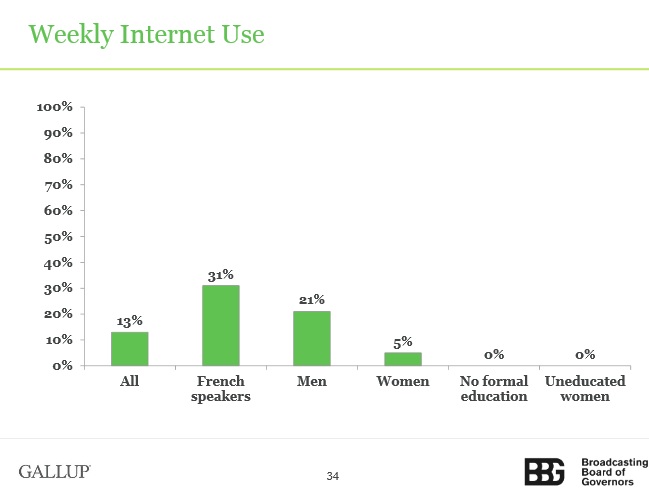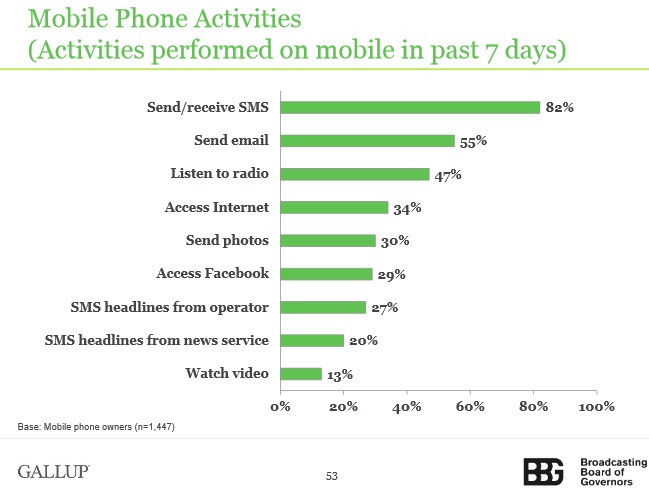Face-to-face media usage surveys in Mali and Somalia shed light on Internet habits
Gallup and the Broadcasting Board of Governors may have personal gain in mind when they research opportunities for international media in Mali and Somalia. The two organizations collaborated earlier in 2013 to determine whether international media could fill a void caused by political unrest that deters local journalism (the answer is it can). Such findings are interesting, but the results of these rare, nationally representative, face-to-face surveys tell of growing mobile internet usage in these two very different nations. Foreign media, namely radio, remains important in both Mali and Somalia, but usage of alternative platforms (ie. the internet) opens up new opportunities to spread news, especially in Somalia. In order to reach marginalized populations in Mali, there needs to be an emphasis on local language content, among skills training.
Mali
A nationally representative face-to-face survey of 1,000 people aged 15 and older living in Bamako was conducted in December 2012 to better understand media usage habits. In general, a lack of language skills prevents many from fully participating in new media, hence a massive gender imbalance. Facebook and search engines are main online news sources. Internet access via mobile is growing but is less extensive than in other markets.
The survey found major online usage discrepancies between men and women, French speakers and non-Francophone Malians:
In addition:
- 90% of Malians say their household has a mobile phone (80% personally own a mobile phone)
- 89% of men own a phone vs. 71% of women
- 92% of those with at least a secondary education own a phone vs. 74% of those with primary or less
- 69% of the population has used SMS messaging in the past week
- 57% listened to the radio on a mobile phone in the past week
- 5% use mobile apps to receive news daily
- 7% use the internet to access daily news (16% French speakers, 0.3% uneducated women)
- 7% accessed a social network in the past week
- 10% of adults “have internet access at home” (mostly mobile devices at home)
- 58% of those who access the internet every week do so at an internet cafe
- 84% of weekly internet users access the internet to find the latest news
Somalia
A nationally representative face-to-face survey of 2,000 Somalis aged 15 and older was conducted in January-February 2013 to better understand media usage habits. Researchers found the Somali media environment to be “unexpectedly sophisticated.” Levels of media use were higher than expected, due to the strong role of Somali diaspora and a lack of government regulation. In all, 72% of Somalis say they own a mobile phone (79% South-Central, 73% Puntland, 56% Somaliland). According to researchers, this statistic is comparable with trends in Nigeria, Zimbabwe, and South Africa (68-73% mobile ownership rates).
The survey found that in the past week:
- 82% of the population has used SMS messaging
- 55% have sent or received an email
- 47% have listened to the radio on a mobile device
- 34% have accessed the internet (a good number of Somali language sites helps)
- 29% interacted with social media (Facebook use is very widespread)
- 13% have watched mobile video
- Education: 68% with some college education have used the internet vs. 54% with a secondary education vs. 10% with a Koranic education
- Geography: 51% of those in Mogadishu go online at least weekly (35% in South-Central Somalia, 9% Somaliland, 3% Puntland)
Source: “Global Hotspots: Media Use in Mali and Somalia 2013,” BBG & Gallup, BBG Research Series, 2013.














 Twitter
Twitter Facebook
Facebook Pinterest
Pinterest